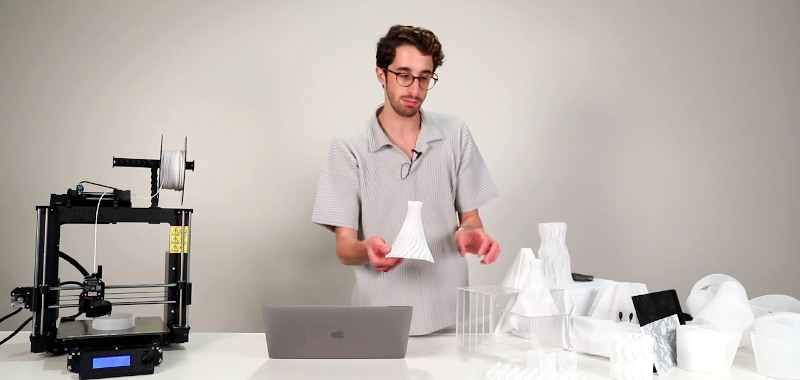Normally, a 3D printer that under extrudes is a bad thing. However, MIT has figured out a way to deliberately mix full extrusions with under extruded layers to print structures that behave more like cloth than normal 3D printed items. The mesh-like structure apparently doesn’t require any modification to a normal 3D printer, just different software to create special code sequences to create the material.
Called DefeXtiles, [Jack Forman] is producing sheets and complex structures that appear woven. The process is known as “blob-stretch” because of the way the plastic makes blobs connected by fine filaments of plastic.
According to the talk by [Jack] (see the second video, below), the technique works with different types of filament and it is possible to print very large items folded up, even on a standard printer. After printing, you simply unfold or unwrap the plastic. For example, by printing a spiral, a 70 meter roll of “fabric” came out of an unremarkable-looking 3D printer. The thickness is under 0.4 mm.
Another example is the full-sized skirts you can see in the paper. They print in a roll form and then expand after printing. Other demonstration objects include a shuttlecock (you know, the thing you use for badminton) and lampshades.
We were hoping to find software or G-code files to demonstrate the technique, but if they were there we missed them. However, it seems like it should be easy enough to create some test files. Let us know if you try.
We’ve seen folding prints before. Fabric like this could transform printing wearables.
















They forgot the most important use: 3D printable TP for the upcoming shortage!
But more seriously I’d love to be able to designate specific areas to print with this instead of normal walls, because it seems totally free of ugly layer lines and might look cool over infills.
They didn’t – first video, 3:20. Impressive 70 meters TP roll!
INSTALL the 3Dprinter in your toilet and enjoy infinite TP.
Just don’t move around too much and you’ll be fine
Pure-plastic clothes seem like an ecological disaster, but hinged enclosures/screened sections for sound and air flow seem useful.
Lots of people wear pure-plastic clothes already (polyester fabrics). 3D-printing fabric-like things is unlikely to make things worse than they already are.
Pure polyester clothes would be a boon, but unfortunately it’s not very comfortable or durable so they mix in cotton, which makes the plastic non-recycleable.
Isn’t pla recyclable?
It’s also biodegradable
https://www.youtube.com/watch?v=X_Gh-3PQhiE
it seems to be a matter of getting a sweet spot between extrusion multiplier and extrusion speed (which is printer dependent). There is a graph showing this on: https://www.media.mit.edu/projects/defextiles/overview/
Expect to see this start to show up at Paris fashion week….
Wouldn’t this be terribly scratchy to wear?
You take it out of the printer before you try to wear it!
B^)
They seem to envision online clothing retailers allowing potential customers to download examples of what they are thinking of buying and trying it on for fit before ordering the real thing. So I guess it only has to feel good enough to tolerate for a fitting. They don’t seem to be talking about actually printing the clothing you wear on a regular basis this way.
Which I guess only amplifies the environmental concern. All that plastic and energy just for a throwaway item.
Easier to use a phone app that takes your measurements and then just sends you real clothes in your size.
Those prints with the floral pattern make me think that if they used an off-white or cream colored filament they would be great as replacement speaker cloth for restoring an antique radio.
This was my exact thought. I was thinking of being able to 3D print the entire snap-close, grill cloth included, enclosure for a wireless bluetooth speaker setup in one print.
PLA is non-petroleum based and biodegradable.
PLA isn’t really “biodegradable”, it’s just “degradable”. You need a commercial composting facility to break it down, it doesn’t happen just in the environment.
https://www.biosphereplastic.com/biodegradableplastic/uncategorized/is-pla-compostable/
Yeah, I thought of this exact augmentation of 3D printing ages ago. I noticed it when I was peeling off rafts or hadn’t finished printing bases (I could stretch them out and they seemed like woven meshes). It’s not that impressive of a discovery. MIT (USA) just think their the best.
Well, the fact that you discovered it ages ago makes me think somebody else would have made this already.
And while you may have discovered the idea behind it, you didn’t make software that could allow you to make fabric in a controlled matter, you just messed up a print.
Really easy to duplicate on Prusa slicer… add a cylinder object, slice using “vase mode” so the perimeter is a single wall one nozzle width. Then find the layer where it starts building the walls in the raw gcode and add “M221 S25” which sets the extrusion multiiplier to 25% and from then on the extruder under extrudes and produces the fabric effect. (PLA setting). If you are using octoprint it is event easier. Just watch until you are printing walls then type in “M221 S25” in the terminal window. Very nice story !
Forgot to add.. .set you print speeds all to 20 mm/sec. Probably fancy ways to insert GCode by faking a color change too.